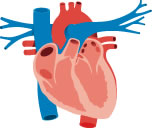Heart Attack >

What is a heart attack?
The heart is responsible for pumping blood around our body. However like all other muscles, it requires its own blood supply. The coronary arteries are responsible for this. The heart is surrounded by three major coronary arteries. If a blood clot develops in one of these arteries, the blood supply to an area of the heart muscle will stop, starving the muscle of oxygen – and a heart attack will occur.
A blood clot can occur if the arteries become damaged, for example by atherosclerosis (hardening of the arteries). Atherosclerosis involves the build up of plaques in the lining of the arteries. If a break occurs in one of these plaques, a blood clot forms at the site and blocks off the blood supply to part of the heart muscle.
A heart attack is also known as myocardial infarction or coronary thrombosis.
What are the symptoms of a heart attack?
The usual symptoms a person may feel are:
- Pain or a feeling of pressure behind the breast bone (sternum) or the left-hand-side of the chest, which lasts 10 minutes or more or goes but then comes back
- Pain spreading to the shoulders, necks, arms or hands. The pain often radiates to the left arm
- Pain may also spread to the jaw, ear or stomach
- A feeling of tightness in or around the throat
- Shortness of breath, even at rest
- Ashen skin
- Fainting and dizziness
- Nausea or vomiting
- Intense sweating
- Frequent angina attacks that are not caused by exertion.
It is important to state that a person does not need to be exhibiting all of these characteristics to be having a heart attack. Some people do not experience any symptoms – or only have mild symptoms during a heart attack. So if a person is only showing one or two signs do not ignore it – it may still be a heart attack. The more signs a person does show however, the more certain you can be that it is a heart attack.
What are the risk factors associated with a heart attack?
Apart from atherosclerosis, there are a number of things which can increase the chances of a person having a heart attack:
- Age – risk of heart attack increases with age
- Hypertension (high blood pressure)
- Male gender
- Family history of heart disease
- Smoking
- Diabetes Type 1 and Type 2
- High cholesterol levels
- Stress
- Obesity
- Lack of exercise.
How is a heart attack diagnosed?
Your doctor will make a diagnosis of heart attack based on a number of factors. It is sometimes a very difficult diagnosis to make and it may take a few days to make sure the diagnosis is correct. First of all, the type of chest pain and how long it lasts is very important information to help make the diagnosis. Secondly your doctor will look at an image of the electricity going through your heart called an electrocardiogram (ECG). There are certain patterns on the ECG, which suggest a heart attack. Lastly, your doctor will carry out blood tests, which will help confirm the diagnosis.
The heart is a muscular bag which squeezes to pump blood around our bodies. Like all muscles it has its own blood supply and the coronary arteries are responsible for bringing blood to the heart muscle. These arteries can become damaged from a condition called atherosclerosis which involves the build up of plaques on the inner surface of the arteries. If a break occurs in one of these plaques, a blood clot forms at this site in the artery and blocks off the blood supply to some of the heart muscle. If this occurs, the muscle gets damaged and the condition is called a heart attack.
Getting over a heart attack
After a heart attack it is important to rest your heart. This will allow the damaged part to heal. At this stage most people will be in a Coronary Care Unit or a step down/sub acute ward but will be on constant heart monitoring. Despite this, it is still possible to carry out some simple exercises in the bed. Taking deep breaths and moving your legs will help your circulation. You will be shown how to do these exercises.
Gradually your strength will return and you will be taken for short walks, first around the bed, then around the ward. In a few more days you will be able to walk by yourself and for longer distances. Usually by this stage you will be off the monitor and out of the Coronary Care Unit.
During this time the doctors will be trying to find out why you had a heart attack. They will have measured the level of cholesterol (blood fat), your weight and blood pressure, asked whether you smoke or not, how much exercise you take, and whether or not anyone else in your family had the same problem. You should try to use this time in hospital to think about your lifestyle and consider ways to improve it in the long term.